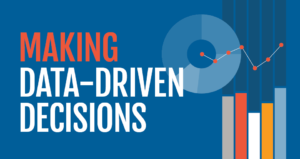 I’ve been to countless team, committee, and Board meetings where entire packets and slide decks of lists, tables, and graphs of data are presented only to be glanced at and set aside. Rarely do we visualize and present data in a way that suggests we could and should reflect on or engage with it. What a waste!
I’ve been to countless team, committee, and Board meetings where entire packets and slide decks of lists, tables, and graphs of data are presented only to be glanced at and set aside. Rarely do we visualize and present data in a way that suggests we could and should reflect on or engage with it. What a waste!
There are so many ways we can present our data that will encourage meaningful engagement with it and, in fact, increase our stakeholders’ appetite for data in planning, evaluation, learning, and improvement efforts.
Make it Meaningful
I’ve said it numerous times before, but it’s worth saying again. First and foremost, make sure the data you present represents clearly defined goals and activities that are meaningful and relevant to your audience’s role and work. (Read these posts for more on getting stakeholders involved in asking questions and driving your data, goal-setting, making goals measurable.)
Make it Pretty
Once you know you’re presenting data that is relevant and meaningful, the next challenge is to present it in engaging ways. There’s a lot of buzz around data visualization these days, so there are lots of great resources out there. Here are a few:
- Ann K. Emery offers a data visualization checklist among other resources and a blog.
- Stephanie Evergreen offers workshops, blogs, and books on the topic.
- This overview of data visualization tips also lists several resources for creating data visualizations, many of which are free.
- This blog gives great tips for how to make the most of Excel when visualizing your data.
- Every Spring, the professional development program at the Brown School offers a workshop on data visualization. Keep an eye on their website for the listing.
Make it a Conversation
Lastly, and most importantly, when you share data with your teams, committees, and Boards, make it a conversation. Not a read-out or recitation or silent review. If you visualize your data in a way that illustrates a story, you can then narrate that story concisely, and invite people to engage with the story.
- Provide Context – Using benchmarks and trendlines in your charts and graphs, you can provide some context. Your audience might also need to know something about how and when you collected the data and what factors influence the quality or accuracy of the data.
- Highlight any Outliers – What’s at the high and low ends? What’s significantly different than the benchmark? What catches your eye? What do want them to notice?
- Share Theories – What does the data suggest to you and your staff team? What could explain the outliers or trends?
- Invite Curiosity – Most importantly, invite your audience to engage with the data. Pose questions that ask them to clarify the data, pose hypotheses, and ask for more or different information so they can drill down next time.
It was in this way that I once created a greater appetite for data among a Board that wasn’t known for its curiosity about or love for data. An initial question, “What data would help you do your jobs?” didn’t garner a lot of specific insight or direction. But once I put something in front of them, they had something to consider, react to, and using as a jumping off point. From there, their appetite for and reliance on data only grew.
